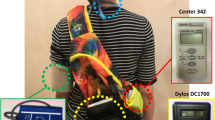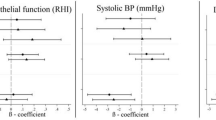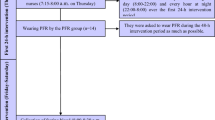Abstract
This study investigates the relationship between ambient fine particle pollution and impaired cardiac autonomic control in the elderly. Heart rate variability (HRV) among 56 elderly (mean age 82) nonsmoking residents of a retirement center in Baltimore County, Maryland, was monitored for 4 weeks, from July 27 through August 22, 1998. The weather was seasonally mild (63–84°F mean daily temperature) with low to moderate levels of fine particles (PM2.5 <50 μg/m3). Two groups of approximately 30 subjects were examined on alternate days. A spline mixed-effects model revealed a negative relationship between outdoor 24-h average fine particulate matter (PM2.5) and high-frequency (HF) HRV that was consistent with our earlier Baltimore study for all but 2 days. These 2 days were the only days with significant precipitation in combination with elevated PM2.5. They were also unusual in that back-trajectoryof their air masses was distinctly different from those on the other study days, emanating from the direction of rural Pennsylvania. Mixed-effects analysis for all 24 study days showed a small negative association of outdoor PM2.5 with HF HRV (−0.03 change in log[HF HRV] for a 10 μg/m3 increment in PM2.5) after adjustment for age, sex, cardiovascular status, trend, maximum temperature, average dew point temperature, random subject intercepts, and autocorrelated residuals. After excluding study days 4 and 5, this association was strengthened (−0.07 change in log[HF HRV] for 10 μg/m3 PM2.5, 95% CI −0.13 to −0.02) and was similar to that obtained in an earlier study (−0.12 change in log[HF HRV] for a 10 μg/m3 increment in outdoor PM2.5, 95% CI −0.24 to −0.00) [Liao D., Cai J., Rosamond W.D., Barnes R.W., Hutchinson R.G., Whitsel E.A., Rautaharju P., and Heiss G. Cardiac autonomic function and incident coronary heart disease: a population-based case-cohort study. The ARIC Study. Atherosclerosis Risk in Communities Study. Am J Epidemiol 1997: 145 (8): 696–706]. Acute (1 to 4 h) previous PM2.5 exposure did not have a stronger impact than the 24-h measure. A distributed lag model incorporating the six preceding 4-h means also did not indicate any effect greater than that observed in the 24-h measure. This study is consistent with earlier findings that exposures to PM2.5 are associated with decreased HRV in the elderly.
This is a preview of subscription content, access via your institution
Access options
Subscribe to this journal
Receive 6 print issues and online access
$259.00 per year
only $43.17 per issue
Buy this article
- Purchase on Springer Link
- Instant access to full article PDF
Prices may be subject to local taxes which are calculated during checkout


Similar content being viewed by others
References
Bates DV, Health indices of the adverse effects of air pollution: the question of coherence. Environ Res (1992) 59(2): 336–349
de Bruyne MC Kors JA Hoes AW Klootwijk P Dekker JM Hofman A van Bemmel JH and Grobbee DE, Both decreased and increased heart rate variability on the standard 10-second electrocardiogram predict cardiac mortality in the elderly: The Rotterdam Study. Am J Epidemiol (1999) 150: 1282–1288
Dekker JM Schouten EG Klootwijk P Pool J Swenne CA and Kromhout D, Heart rate variability from short electrocardiographic recordings predicts mortality from all causes in middle-aged and elderly men. The Zutphen Study. Am J Epidemiol (1997) 145: 899–908
Dockery DW and Pope CA III, Acute respiratory effects of particulate air pollution. Annu Rev Public Health (1994) 15: 107–132
Draxler RR and Hess GD, Description of the HYSPLIT_4 Modeling System. NOAA Technical Memorandum ERL ARL-224 1998http://www.arl.noaa.gov/ready/hysplit4.html.NOAA Air Resources Laboratory, Silver Spring, MD
Lebowitz MD, Epidemiological studies of the respiratory effects of air pollution. Eur Respir J (1996) 9: 1029–1054
Liao D Cai J Rosamond WD Barnes RW Hutchinson RG Whitsel EA Rautaharju P and Heiss G, Cardiac autonomic function and incident coronary heart disease: a population-based case-cohort study. The ARIC Study. Atherosclerosis Risk in Communities Study. Am J Epidemiol (1997) 145(8): 696–706
Liao D, Creason J, Shy C, Williams R, Watts R, and Zweidinger R, Daily variation of particulate air pollution and poor cardiac autonomic control in the elderly. Environ Health Perspect (1999) 107(7): 521–525
Lippmann M, and Thurston GD, Sulfate concentrations as an indicator of ambient particulate matter air pollution for health risk evaluations. J Exposure Anal Environ Epidemiol (1996) 6: 123–146
Littell RC Milliken GA Stroup WW and Wolfinger RD, SAS® System for Mixed Models. SAS Institute, Inc., Cary, NC 1996
National Research Council, Committee on Research Priorities for Airborne Particulate Matter. Research Priorities for Airborne Particulate Matter: I. Immediate Priorities and a Long-Range Research Portfolio. National Academy Press, Washington, DC 1998
Peters A Liu E Verrier RL Schwartz J Gold DR Mittleman M Baliff J Oh JA Allen G Monahan K and Dockery DW, Air pollution and incidence of cardiac arrhythmia. Epidemiology (2000) 11: 11–17
Peters A, Perz S, Doring A, Stieber J, Koenig W, and Wichmann HE, Increases in heart rate during an air pollution episode. Am J Epidemiol (1999) 150: 1094–1098
Pope CA III, Dockery DW Kanner RE Villegas GM and Schwartz J, Oxygen saturation, pulse rate, and particulate air pollution: A daily time-series panel study. Am J Respir Crit Care Med (1999) 159: 365–372
Pope CA III, Verrier RL Lovett EG Larson AC Raizenne ME Kanner RE Schwartz J Villegas GM Gold DR and Dockery DW, Heart rate variability associated with particulate air pollution. Am Heart J (1999) 138: 890–899
Task Force of the European Society of Cardiology and the North American Society of Pacing and Electrophysiology, Heart rate variability — standards of measurement, physiological interpretation, and clinical use. Circulation (1996) 93: 1043–1065
Tsuji H Venditti FJ Jr. Manders ES Evans JC Larson MG Feldman CL and Levy D, Reduced heart rate variability and mortality risk in an elderly cohort. The Framingham Heart Study. Circulation (1994) 90: 878–883
Williams R, Creason J, Zweidinger R, Watts R, Sheldon L, and Shy C, Indoor, outdoor, and personal exposure monitoring of particulate air pollution; The Baltimore elderly epidemiology-exposure pilot study. Atmos Environ (2000a) 34: 4193–4204
Williams R, Suggs J, Rodes C, Lawless P, Zweidinger R, Kwok R, Creason J, and Sheldon L, Comparison of PM2.5 and PM10 Monitors. J Exposure Anal Environ Epidemiol (2000b) 10: 497–505
Williams R, Suggs J, Zweidinger R, Evans G, Creason J, Kwok R, Rodes C, Lawless P, and Sheldon L, The 1998 Baltimore particulate matter epidemiology-exposure study: Part 1. Comparison of ambient, residential outdoor, indoor and apartment particulate matter monitoring. J Exposure Anal Environ Epidemiol (2000c) 10: 518–532
Williams R, Suggs J, Creason J, Rodes R, Lawless P, Kwok R, Zweidinger R, and Sheldon L, The 1998 Baltimore particulate matter epidemiology-exposure study: Part 2. Personal exposure assessment associated with an elderly study population. J Exposure Anal Environ Epidemiol (2000d) 10: 533–543
Acknowledgements
The participation of D. Liao and C. Shy in this study was funded through cooperative agreement CR820076 between the Human Studies Division (National Health and Environmental Effects Research Laboratory, U.S. EPA) and the Department of Epidemiology (School of Public Health, University of North Carolina at Chapel Hill, Chapel Hill, NC). Health measurements were conducted in the field under contract to Westat, Contract No. 68-D-98-115. Exposure measurements were administered under EPA-NERL Contract No. 68-D5-0040 with the Research Triangle Institute (RTI). The authors would like to thank EPA field study team members Richard Kwok, Scott Rhoney, and Ed Hudgens for their dedicated efforts that resulted in the excellent data quality achieved, and Westat field supervisors Shirley Friend and Vickie Klementowicz who contributed greatly to the success of this study. The views expressed in this article are those of the individual authors and do not necessarily reflect the views and policies of the EPA. The research described in this article has been subject to EPA's peer and administrative review and it has been approved for publication.
Author information
Authors and Affiliations
Corresponding author
Rights and permissions
About this article
Cite this article
CREASON, J., NEAS, L., WALSH, D. et al. Particulate matter and heart rate variability among elderly retirees: the Baltimore 1998 PM study. J Expo Sci Environ Epidemiol 11, 116–122 (2001). https://doi.org/10.1038/sj.jea.7500154
Published:
Issue Date:
DOI: https://doi.org/10.1038/sj.jea.7500154
This article is cited by
-
Neural mechanism facilitating PM2.5-related cardiac arrhythmias through cardiovascular autonomic and calcium dysregulation in a rat model
Scientific Reports (2023)
-
Personal exposure to particulate matter and heart rate variability among informal electronic waste workers at Agbogbloshie: a longitudinal study
BMC Public Health (2021)
-
Effects of Trans, Trans-2,4-decadienal on the Ions Currents of Cardiomyocytes: Possible Mechanisms of Arrhythmogenesis Induced by Cooking-oil Fumes
Scientific Reports (2020)
-
Association between PM2.5 exposure and heart rate variability for the patients with cardiac problems in Japan
Air Quality, Atmosphere & Health (2020)
-
Association between traffic emissions mixed with resuspended dust and heart rate variability among healthy adults in Delhi
Air Quality, Atmosphere & Health (2020)



